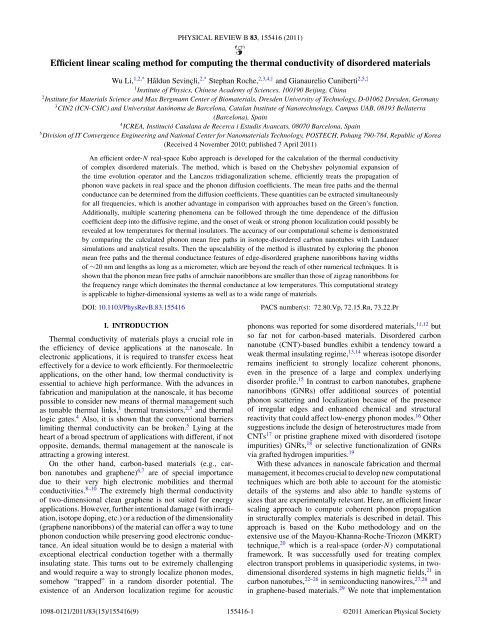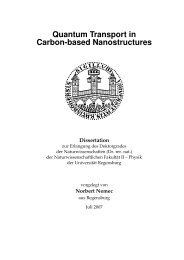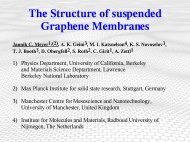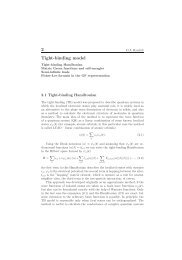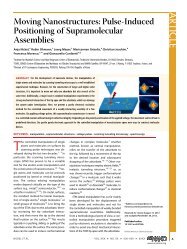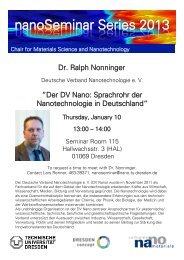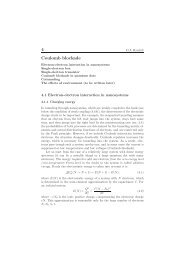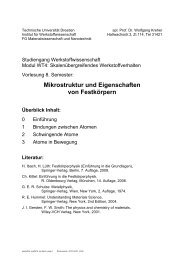Efficient linear scaling method for computing the thermal conductivity ...
Efficient linear scaling method for computing the thermal conductivity ...
Efficient linear scaling method for computing the thermal conductivity ...
Create successful ePaper yourself
Turn your PDF publications into a flip-book with our unique Google optimized e-Paper software.
PHYSICAL REVIEW B 83, 155416 (2011)<br />
<strong>Efficient</strong> <strong>linear</strong> <strong>scaling</strong> <strong>method</strong> <strong>for</strong> <strong>computing</strong> <strong>the</strong> <strong>the</strong>rmal <strong>conductivity</strong> of disordered materials<br />
Wu Li, 1,2,* Hâldun Sevinçli, 2,* Stephan Roche, 2,3,4,† and Gianaurelio Cuniberti2,5,‡ 1Institute of Physics, Chinese Academy of Sciences, 100190 Beijing, China<br />
2Institute <strong>for</strong> Materials Science and Max Bergmann Center of Biomaterials, Dresden University of Technology, D-01062 Dresden, Germany<br />
3CIN2 (ICN-CSIC) and Universitat Autónoma de Barcelona, Catalan Institute of Nanotechnology, Campus UAB, 08193 Bellaterra<br />
(Barcelona), Spain<br />
4ICREA, Institució Catalana de Recerca i Estudis Avancats, 08070 Barcelona, Spain<br />
5Division of IT Convergence Engineering and National Center <strong>for</strong> Nanomaterials Technology, POSTECH, Pohang 790-784, Republic of Korea<br />
(Received 4 November 2010; published 7 April 2011)<br />
An efficient order-N real-space Kubo approach is developed <strong>for</strong> <strong>the</strong> calculation of <strong>the</strong> <strong>the</strong>rmal <strong>conductivity</strong><br />
of complex disordered materials. The <strong>method</strong>, which is based on <strong>the</strong> Chebyshev polynomial expansion of<br />
<strong>the</strong> time evolution operator and <strong>the</strong> Lanczos tridiagonalization scheme, efficiently treats <strong>the</strong> propagation of<br />
phonon wave packets in real space and <strong>the</strong> phonon diffusion coefficients. The mean free paths and <strong>the</strong> <strong>the</strong>rmal<br />
conductance can be determined from <strong>the</strong> diffusion coefficients. These quantities can be extracted simultaneously<br />
<strong>for</strong> all frequencies, which is ano<strong>the</strong>r advantage in comparison with approaches based on <strong>the</strong> Green’s function.<br />
Additionally, multiple scattering phenomena can be followed through <strong>the</strong> time dependence of <strong>the</strong> diffusion<br />
coefficient deep into <strong>the</strong> diffusive regime, and <strong>the</strong> onset of weak or strong phonon localization could possibly be<br />
revealed at low temperatures <strong>for</strong> <strong>the</strong>rmal insulators. The accuracy of our computational scheme is demonstrated<br />
by comparing <strong>the</strong> calculated phonon mean free paths in isotope-disordered carbon nanotubes with Landauer<br />
simulations and analytical results. Then <strong>the</strong> upscalability of <strong>the</strong> <strong>method</strong> is illustrated by exploring <strong>the</strong> phonon<br />
mean free paths and <strong>the</strong> <strong>the</strong>rmal conductance features of edge-disordered graphene nanoribbons having widths<br />
of ∼20 nm and lengths as long as a micrometer, which are beyond <strong>the</strong> reach of o<strong>the</strong>r numerical techniques. It is<br />
shown that <strong>the</strong> phonon mean free paths of armchair nanoribbons are smaller than those of zigzag nanoribbons <strong>for</strong><br />
<strong>the</strong> frequency range which dominates <strong>the</strong> <strong>the</strong>rmal conductance at low temperatures. This computational strategy<br />
is applicable to higher-dimensional systems as well as to a wide range of materials.<br />
DOI: 10.1103/PhysRevB.83.155416 PACS number(s): 72.80.Vp, 72.15.Rn, 73.22.Pr<br />
I. INTRODUCTION<br />
Thermal <strong>conductivity</strong> of materials plays a crucial role in<br />
<strong>the</strong> efficiency of device applications at <strong>the</strong> nanoscale. In<br />
electronic applications, it is required to transfer excess heat<br />
effectively <strong>for</strong> a device to work efficiently. For <strong>the</strong>rmoelectric<br />
applications, on <strong>the</strong> o<strong>the</strong>r hand, low <strong>the</strong>rmal <strong>conductivity</strong> is<br />
essential to achieve high per<strong>for</strong>mance. With <strong>the</strong> advances in<br />
fabrication and manipulation at <strong>the</strong> nanoscale, it has become<br />
possible to consider new means of <strong>the</strong>rmal management such<br />
as tunable <strong>the</strong>rmal links, 1 <strong>the</strong>rmal transistors, 2,3 and <strong>the</strong>rmal<br />
logic gates. 4 Also, it is shown that <strong>the</strong> conventional barriers<br />
limiting <strong>the</strong>rmal <strong>conductivity</strong> can be broken. 5 Lying at <strong>the</strong><br />
heart of a broad spectrum of applications with different, if not<br />
opposite, demands, <strong>the</strong>rmal management at <strong>the</strong> nanoscale is<br />
attracting a growing interest.<br />
On <strong>the</strong> o<strong>the</strong>r hand, carbon-based materials (e.g., carbon<br />
nanotubes and graphene) 6,7 are of special importance<br />
due to <strong>the</strong>ir very high electronic mobilities and <strong>the</strong>rmal<br />
conductivities. 8–10 The extremely high <strong>the</strong>rmal <strong>conductivity</strong><br />
of two-dimensional clean graphene is not suited <strong>for</strong> energy<br />
applications. However, fur<strong>the</strong>r intentional damage (with irradiation,<br />
isotope doping, etc.) or a reduction of <strong>the</strong> dimensionality<br />
(graphene nanoribbons) of <strong>the</strong> material can offer a way to tune<br />
phonon conduction while preserving good electronic conductance.<br />
An ideal situation would be to design a material with<br />
exceptional electrical conduction toge<strong>the</strong>r with a <strong>the</strong>rmally<br />
insulating state. This turns out to be extremely challenging<br />
and would require a way to strongly localize phonon modes,<br />
somehow “trapped” in a random disorder potential. The<br />
existence of an Anderson localization regime <strong>for</strong> acoustic<br />
phonons was reported <strong>for</strong> some disordered materials, 11,12 but<br />
so far not <strong>for</strong> carbon-based materials. Disordered carbon<br />
nanotube (CNT)-based bundles exhibit a tendency toward a<br />
weak <strong>the</strong>rmal insulating regime, 13,14 whereas isotope disorder<br />
remains inefficient to strongly localize coherent phonons,<br />
even in <strong>the</strong> presence of a large and complex underlying<br />
disorder profile. 15 In contrast to carbon nanotubes, graphene<br />
nanoribbons (GNRs) offer additional sources of potential<br />
phonon scattering and localization because of <strong>the</strong> presence<br />
of irregular edges and enhanced chemical and structural<br />
reactivity that could affect low-energy phonon modes. 16 O<strong>the</strong>r<br />
suggestions include <strong>the</strong> design of heterostructures made from<br />
CNTs 17 or pristine graphene mixed with disordered (isotope<br />
impurities) GNRs, 18 or selective functionalization of GNRs<br />
via grafted hydrogen impurities. 19<br />
With <strong>the</strong>se advances in nanoscale fabrication and <strong>the</strong>rmal<br />
management, it becomes crucial to develop new computational<br />
techniques which are both able to account <strong>for</strong> <strong>the</strong> atomistic<br />
details of <strong>the</strong> systems and also able to handle systems of<br />
sizes that are experimentally relevant. Here, an efficient <strong>linear</strong><br />
<strong>scaling</strong> approach to compute coherent phonon propagation<br />
in structurally complex materials is described in detail. This<br />
approach is based on <strong>the</strong> Kubo <strong>method</strong>ology and on <strong>the</strong><br />
extensive use of <strong>the</strong> Mayou-Khanna-Roche-Triozon (MKRT)<br />
technique, 20 which is a real-space (order-N) computational<br />
framework. It was successfully used <strong>for</strong> treating complex<br />
electron transport problems in quasiperiodic systems, in twodimensional<br />
disordered systems in high magnetic fields, 21 in<br />
carbon nanotubes, 22–26 in semiconducting nanowires, 27,28 and<br />
in graphene-based materials. 29 We note that implementation<br />
1098-0121/2011/83(15)/155416(9) 155416-1<br />
©2011 American Physical Society
LI, SEVINÇLI, ROCHE, AND CUNIBERTI PHYSICAL REVIEW B 83, 155416 (2011)<br />
of <strong>the</strong> Lanczos <strong>method</strong> <strong>for</strong> <strong>computing</strong> <strong>the</strong> Landauer-Büttiker<br />
conductance of low-dimensional systems was also reported. 30<br />
In this paper, we first extend our recent communication<br />
on <strong>the</strong> <strong>method</strong> 31 to a complete derivation of <strong>the</strong> phonon<br />
transmission coefficient starting from <strong>the</strong> original Kubo<br />
<strong>for</strong>mula and within <strong>the</strong> harmonic approximation. This means<br />
that only elastic scattering (due, <strong>for</strong> instance, to isotope<br />
disorder) is introduced, disregarding anharmonic effects. The<br />
study of <strong>the</strong> dynamical properties of phonon wave packets<br />
is also related to <strong>the</strong> <strong>the</strong>rmal conductance, which requires a<br />
phonon frequency integration over <strong>the</strong> whole spectrum. We<br />
<strong>the</strong>n validate <strong>the</strong> <strong>method</strong> by comparison with o<strong>the</strong>r numerical<br />
approaches and analytical results, and we fur<strong>the</strong>r apply this<br />
<strong>method</strong> to edge-disordered GNRs and discuss its limits.<br />
II. COMPUTATIONAL PHONON TRANSPORT<br />
METHODOLOGY<br />
The electronic transport <strong>the</strong>ory in <strong>the</strong> <strong>linear</strong> response regime<br />
generally relies on <strong>the</strong> approach derived by Kubo. 32 To investigate<br />
bulk quantum phonon transport in disordered materials,<br />
<strong>the</strong> use of <strong>the</strong> Kubo <strong>for</strong>malism turns out to be <strong>the</strong> most natural<br />
and computationally efficient one. It has already been used <strong>for</strong><br />
investigating <strong>the</strong>rmal transport in disordered binary alloys or<br />
nanocrystalline silicon. 33,34 Inspired by <strong>the</strong> MKRT scheme <strong>for</strong><br />
electron transport, 20 we derive a real-space implementation of<br />
<strong>the</strong> Kubo <strong>for</strong>mula <strong>for</strong> phonon propagation, which establishes<br />
a direct computational bridge between phonon dynamics and<br />
<strong>the</strong>rmal conductance. In contrast to o<strong>the</strong>r implementations of<br />
<strong>the</strong> Kubo approach, we extract dynamical in<strong>for</strong>mation from <strong>the</strong><br />
time evolution of <strong>the</strong> wave packet 35 (based on <strong>the</strong> expansion of<br />
<strong>the</strong> evolution operator on a Chebyshev polynomials basis) and<br />
simulate quantum dynamics instead of solving <strong>the</strong> Newtonian<br />
equations of motion. 36–38 There<strong>for</strong>e, a single initial condition is<br />
enough (i.e., <strong>the</strong> initial atomic displacements) without any need<br />
to compute <strong>the</strong> time-dependent atomic velocities. Additionally,<br />
by using <strong>the</strong> Lanczos technique, one can avoid any matrix<br />
inversions, and a considerable gain in computational efficiency<br />
is obtained, which allows <strong>the</strong> study of very large-scale<br />
materials.<br />
A. Derivation of <strong>the</strong> phonon transport equations<br />
The vibrational Hamiltonian, taking only <strong>the</strong> harmonic<br />
interactions into account, is described as<br />
H = ˆp<br />
i<br />
2 i<br />
+<br />
2Mi<br />
<br />
ij ûiûj , (1)<br />
ij<br />
where ûi and ˆpi are <strong>the</strong> displacement and momentum operators<br />
<strong>for</strong> <strong>the</strong> ith atomic degree of freedom, Mi is <strong>the</strong> corresponding<br />
mass, and is <strong>the</strong> <strong>for</strong>ce constant tensor. Based on <strong>the</strong><br />
<strong>linear</strong> response <strong>the</strong>ory, <strong>the</strong> phonon <strong>conductivity</strong> σ along <strong>the</strong> x<br />
direction can be obtained as34 σ = T −1 β ∞<br />
lim lim dλ dt e<br />
ω→0 η→0 0 0<br />
i(ω+iη)t 〈 Jˆ x (−i¯hλ) Jˆ x (t)〉,<br />
(2)<br />
with being <strong>the</strong> system volume and T being <strong>the</strong> temperature;<br />
Jˆ x is <strong>the</strong> x component of <strong>the</strong> energy flux operator ˆJ, and it can<br />
be expressed as Jˆ x = 1/2 <br />
ij (Xi − Xj )ij ûi ˆvj , where ˆvj<br />
is <strong>the</strong> velocity operator and Xi is <strong>the</strong> equilibrium position of<br />
<strong>the</strong> atom to which <strong>the</strong> ith degree of freedom belongs. After<br />
neglecting terms like â † mâ † n and âmân, Jˆ x can be rewritten in<br />
terms of <strong>the</strong> phonon creation and annihilation operators as<br />
Jˆ x = <br />
m,n J x mn↠mân, where<br />
J x mn =−i¯h<br />
<br />
ωm ωn<br />
+ 〈m|[X,D]|n〉. (3)<br />
4 ωn ωm<br />
In Eq. (3), X is <strong>the</strong> diagonal matrix of equilibrium positions,<br />
D is <strong>the</strong> mass normalized dynamical matrix with Dij =<br />
ij / MiMj , and |n〉 is <strong>the</strong> nth eigenstate of D. Allen and<br />
Feldman have shown that Eq. (2) can be written as34 σ = π ∂fB<br />
J<br />
¯hT ∂ωm m,n<br />
x mnJ x nmδ(ωm − ωn), (4)<br />
where fB is <strong>the</strong> Bose distribution function. There<strong>for</strong>e, one has<br />
σ =− π<br />
∞<br />
dω<br />
0<br />
¯h ∂fB<br />
4ω ∂T<br />
× Tr{[ ˆX,D]δ(ω − √ D)[ ˆX,D]δ(ω − √ D)}, (5)<br />
where √ D = <br />
n ωn|n〉〈n| acts as <strong>the</strong> free particle Hamiltonian,<br />
δ(···) is <strong>the</strong> Dirac delta function, and Tr{···}stands <strong>for</strong><br />
<strong>the</strong> trace operator. Defining Vx =−i[X, √ D], one can write<br />
<strong>the</strong> <strong>the</strong>rmal conductance of a one-dimensional system as<br />
κ = π<br />
L2 ∞<br />
dω¯hω<br />
0<br />
∂fB<br />
∂T Tr{Vxδ(ω − √ D)Vxδ(ω − √ D)}.<br />
(6)<br />
The <strong>the</strong>rmal conductance can also be derived from <strong>the</strong><br />
Landauer <strong>for</strong>malism39 or <strong>the</strong> nonequilibrium Green’s function<br />
approach40 as<br />
κ = 1<br />
∞<br />
dω¯hω<br />
2π 0<br />
∂fB<br />
T (ω), (7)<br />
∂T<br />
with T (ω) being <strong>the</strong> phonon transmission function. Comparing<br />
<strong>the</strong>se two <strong>for</strong>mulas, we obtain <strong>the</strong> transmission function as<br />
155416-2<br />
2 2π<br />
T (ω) =<br />
L2 Tr{Vxδ(ω − √ D)Vxδ(ω − √ D)}. (8)<br />
The phonon transmission function derived here has exactly <strong>the</strong><br />
same <strong>for</strong>m as <strong>the</strong> electron transmission function derived from<br />
<strong>the</strong> Kubo-Greenwood <strong>for</strong>mula, 20<br />
Tel(E) = 2π 2¯h 2<br />
L2 Tr{ ˆVxδ(E − ˆHel) ˆVxδ(E − ˆHel)}, (9)<br />
where ˆHel is <strong>the</strong> electronic Hamiltonian.<br />
We rewrite <strong>the</strong> Kubo <strong>for</strong>mula in a more convenient <strong>for</strong>m <strong>for</strong><br />
<strong>the</strong> real-space study of <strong>the</strong> wave-packet dynamics. Expressing<br />
<strong>the</strong> δ-function as<br />
δ(ω − √ D) = 1<br />
∞<br />
dt e<br />
2π −∞<br />
i(ω−√D)t , (10)<br />
one can <strong>the</strong>n rewrite T (ω)L2 /π as<br />
∞<br />
dtTr{δ(ω − √ D)}〈Vx(t)Vx(0)〉ω<br />
−∞<br />
∞<br />
=<br />
0<br />
dtTr{δ(ω − √ D)}〈Vx(t)Vx(0) + Vx(0)Vx(t)〉ω,<br />
(11)
EFFICIENT LINEAR SCALING METHOD FOR COMPUTING ... PHYSICAL REVIEW B 83, 155416 (2011)<br />
where Vx(t) = U † (t)VxU(t) with U(t) = e −i√ Dt , and 〈···〉ω<br />
denotes <strong>the</strong> mean value of <strong>the</strong> operator over different eigenstates<br />
with frequency ω. The mean-square displacement along<br />
<strong>the</strong> x direction over <strong>the</strong> states having frequency ω is written as<br />
χ 2 (ω,t) =〈(X(t) − X(0)) 2 〉ω, (12)<br />
where χ(t) = U † (t)χU(t). Hence,<br />
d<br />
dt χ 2 (ω 2 ,t) =〈Vx(0)(X(0) − X(−t))<br />
+ (X(0) − X(−t))Vx(0)〉ω, (13)<br />
and<br />
d2 dt2 χ 2 (ω 2 ,t) =〈Vx(t)Vx(0) + Vx(0)Vx(t)〉ω. (14)<br />
Using d<br />
dt χ 2 (ω2 ,t)|t=0 = 0, <strong>the</strong> integral in Eq. (11) can be<br />
evaluated as<br />
T (ω) = 2ωπ<br />
L2 Tr{δ(ω2 d<br />
− D)} lim<br />
t→∞ dt χ 2 (ω,t). (15)<br />
We consider 〈Vx(0)Vx(t)〉ω = v2 (ω)e−t/τtr , where v(ω) and τtr<br />
stand <strong>for</strong> <strong>the</strong> average group velocity and <strong>the</strong> average transport<br />
time at frequency ω, respectively. With this approximation, <strong>the</strong><br />
multiple scattering effects are taken into account in an average<br />
manner, and <strong>the</strong> mean-square displacement is obtained as<br />
χ 2 (ω,t) = 2v 2 τtrt − 2v 2 τ 2<br />
tr + 2v2τ 2<br />
tre−t/τtr . (16)<br />
The diffusion coefficient is defined as<br />
D(ω,t) = χ 2 (ω,t)<br />
; (17)<br />
t<br />
<strong>the</strong>re<strong>for</strong>e. in <strong>the</strong> ballistic regime t ≪ τtr and D(ω,t) = v2t, while in <strong>the</strong> diffusive regime t ≫ τtr and D(ω,t) = Dmax(ω) =<br />
2v2τtr. The transmission function in <strong>the</strong> diffusive regime<br />
reduces to<br />
T (ω) = 2ωπ<br />
L2 Tr{δ(ω2 − D)}Dmax(ω). (18)<br />
The phonon transport mean free path (MFP) can be obtained<br />
via<br />
ℓ(ω) = vτtr = Dmax(ω)<br />
. (19)<br />
2v(ω)<br />
We note that ℓ(ω) can also be approximated by T (ω)L/2Nch,<br />
which gives <strong>the</strong> same result as Eq. (19), because in a quasione-dimensional<br />
system <strong>the</strong> number of channels is Nch(ω) ≈<br />
2ωπTr{δ(ω2 − D)}v(ω)/L.<br />
By <strong>computing</strong> D(ω,t), one can thus deduce Dmax(ω) and<br />
v(ω) and ℓ(ω). Noticing that<br />
χ 2 (ω,t) = Tr{(X(t) − X(0))2δ(ω2 − D)}<br />
Tr{δ(ω2 − D)}<br />
= Tr{[X,U(t)]† δ(ω2 − D)[X,U(t)]}<br />
Tr{δ(ω2 , (20)<br />
− D)}<br />
<strong>the</strong> trace in <strong>the</strong> numerator can be calculated efficiently<br />
through an average over a few random phase states as<br />
N〈ψ|[X,U(t)] † δ(ω2 − D)[X,U(t)]|ψ〉, where N is <strong>the</strong> number<br />
of degrees of freedom and <strong>the</strong> bra-ket corresponds to a<br />
kind of projected density of states (PDOS) associated with <strong>the</strong><br />
155416-3<br />
vector [X,U(t)]|ψ〉. PDOS differs from <strong>the</strong> normal PDOS by<br />
a factor of 1/2ω and is obtained by using <strong>the</strong> Lanczos <strong>method</strong>.<br />
The value of Tr{δ(ω2 − D)} is also calculated by averaging<br />
<strong>the</strong> PDOS of |ψ〉 through <strong>the</strong> Lanczos <strong>method</strong>. The vector<br />
[X,U(t)]|ψ〉 is calculated by using <strong>the</strong> Chebyshev expansion<br />
of U(t); however, <strong>the</strong> very low frequency component cannot<br />
be evaluated with a reasonable accuracy <strong>for</strong> large t, which<br />
is discussed in Sec. II C. If we trans<strong>for</strong>m U(t) → U(τ) =<br />
e−iDτ , <strong>the</strong> corresponding velocity and <strong>the</strong> transport time are<br />
trans<strong>for</strong>med as v → 2ωv and τtr → τtr/2ω, up to <strong>the</strong> first-order<br />
approximation of <strong>the</strong> perturbation of <strong>the</strong> dynamical matrix D.<br />
There<strong>for</strong>e, Eq. (20) can be approximated by<br />
χ 2 (ω,t) ≈ Tr{[X,U(t/2ω)]† δ(ω2 − D)[X,U(t/2ω)]}<br />
Tr{δ(ω2 , (21)<br />
− D)}<br />
so we can expand U(τ) instead of U(t) in terms of <strong>the</strong><br />
Chebyshev polynomials.<br />
B. Lanczos and continued fraction <strong>method</strong>s<br />
<strong>Efficient</strong> computational recursion and order-N <strong>method</strong>s<br />
have been successfully developed in solid-state physics,<br />
starting from <strong>the</strong> pioneering work by Haydock. 41–43 The<br />
recursion <strong>method</strong>s are based on an eigenvalue approach of<br />
Lanczos44 and rely on <strong>the</strong> computation of Green’s function<br />
matrix elements by continued fraction expansion, which<br />
can be implemented in ei<strong>the</strong>r real or reciprocal spaces.<br />
These techniques are particularly well suited <strong>for</strong> treating<br />
disordered materials (e.g., alloys) and defect-related problems,<br />
and <strong>the</strong>y were successfully implemented to tackle impuritylevel<br />
calculations in semiconductors using <strong>the</strong> tight-binding<br />
approximation, 45 or to investigate <strong>the</strong> electronic structure of<br />
amorphous semiconductors, transition metals, and metallic<br />
glasses based on <strong>linear</strong>-muffin-tin orbitals. 46 The vibrational<br />
density of states (DOS) of disordered materials has also been<br />
investigated by <strong>the</strong> recursion <strong>method</strong>. 47<br />
Owing to <strong>the</strong> δ function, <strong>the</strong> numerator and <strong>the</strong> denominator<br />
can be considered PDOS on |ψ〉 and [X,U(t)]|ψ〉, respectively.<br />
Given |ψ〉 and assuming that [X,U(t)]|ψ〉 is already known,<br />
we can use <strong>the</strong> continued fraction <strong>method</strong> to calculate PDOS.<br />
We tridiagonalize <strong>the</strong> dynamical matrix D from an initial<br />
state |ψ〉 or [X,U(t)]|ψ〉 by using <strong>the</strong> Lanczos scheme. The<br />
Lanczos coefficients an and bn display a convenient feature:<br />
<strong>the</strong>y converge rapidly to constants a∞ and b∞, respectively,<br />
<strong>for</strong> a reasonable number of recursion steps. The PDOS is <strong>the</strong>n<br />
deduced from <strong>the</strong> first diagonal element of retarded Green’s<br />
function in <strong>the</strong> tridiagonalized representation. For instance,<br />
〈ψ|δ(ω 2 − D)|ψ〉 =− 1<br />
π lim<br />
η→0 Im〈ψ|<br />
1<br />
ω2 |ψ〉, (22)<br />
+ iη − D<br />
and limη→0〈ψ|(ω 2 + iη − D) −1 |ψ〉 can be expressed as a<br />
continued fraction:<br />
1<br />
ω2 b<br />
+ iη − a1 −<br />
2 1<br />
ω 2 b<br />
+ iη − a2 −<br />
2 .<br />
2<br />
. ..<br />
ω 2 + iη − aN − b 2 N(ω) (23)
LI, SEVINÇLI, ROCHE, AND CUNIBERTI PHYSICAL REVIEW B 83, 155416 (2011)<br />
PDOS (arbitrary unit)<br />
a n<br />
b n<br />
0 20 40 60 80 100<br />
Recursion number n<br />
0 200 400 600 800 1000 1200 1400 1600<br />
ω (cm −1 )<br />
FIG. 1. (Color online) Vibrational PDOS on a single random<br />
phase state <strong>for</strong> a clean two-dimensional graphene system calculated<br />
by using <strong>the</strong> <strong>for</strong>ce constants given in Ref. 53. The Lanczos coefficients<br />
are shown in <strong>the</strong> inset.<br />
In practice, <strong>the</strong> continued fraction is terminated after a certain<br />
step N by <strong>the</strong> approximation aN+1 = a∞ and bN+1 = b∞.The<br />
termination can be analytically obtained as<br />
(ω) = ω2 + iη − a∞ − i (2b∞) 2 − (ω2 + iη − a∞) 2<br />
.<br />
2b 2 ∞<br />
(24)<br />
As an example, <strong>the</strong> normal PDOS on a single random phase<br />
state <strong>for</strong> a clean two-dimensional graphene system is given in<br />
Fig. 1. It already agrees well with <strong>the</strong> DOS obtained by direct<br />
matrix diagonalization. The inset shows <strong>the</strong> corresponding<br />
Lanczos coefficients, a(n) and b(n).<br />
C. Chebyshev polynomial expansion<br />
The evolution of <strong>the</strong> vector [X,U(t)]|ψ〉 is determined by<br />
U(t). Although U(t) has a simple <strong>for</strong>m, its exact calculation<br />
requires diagonalization of <strong>the</strong> dynamical matrix. Provided<br />
that all <strong>the</strong> eigenvalues and eigenvectors of D are known,<br />
<strong>the</strong> matrix <strong>for</strong>m of U(t) can be obtained by using a unitary<br />
trans<strong>for</strong>mation. The diagonalization of a matrix requires<br />
O(N 3 ) operations, so it is practically impossible to handle a<br />
system with size N 10 6 . One can employ Taylor expansion,<br />
but <strong>the</strong> efficiency and <strong>the</strong> accuracy are difficult to fulfill at<br />
<strong>the</strong> same time with such an expansion, especially because<br />
higher accuracy requires ei<strong>the</strong>r a larger number of time steps or<br />
larger expansion orders <strong>for</strong> a given time t. The implementation<br />
of <strong>the</strong> Taylor expansion <strong>for</strong> studying long time propagation<br />
of wave packets in large-scale disordered systems with high<br />
accuracy is <strong>the</strong>re<strong>for</strong>e beyond today’s computational reach.<br />
Instead, we use orthogonal polynomials. In principle, any set of<br />
orthogonal polynomials could be used <strong>for</strong> expanding <strong>the</strong> time<br />
evolution operator. On <strong>the</strong> o<strong>the</strong>r hand, Chebyshev polynomials<br />
have been widely used in past literature due to a particularly<br />
well achieved numerical stability, 20,38 and <strong>for</strong> this reason<br />
we employ <strong>the</strong> Chebyshev polynomial expansion approach.<br />
Formally, one can expand any function of an operator in<br />
terms of Chebyshev polynomial-based operators, since <strong>the</strong> set<br />
of Chebyshev polynomials Qn <strong>for</strong>m a complete orthogonal<br />
basis set. The expansion coefficients depend on <strong>the</strong> <strong>for</strong>m<br />
of <strong>the</strong> expanded function, on <strong>the</strong> time step t, and on <strong>the</strong><br />
function domain [a − 2b,a + 2b], which should cover <strong>the</strong><br />
whole spectrum of <strong>the</strong> dynamical matrix D. Since Chebyshev<br />
polynomials are defined in <strong>the</strong> interval [−1,1], we first need<br />
to scale and shift <strong>the</strong> argument so that it falls within <strong>the</strong> range<br />
based on D ′ = (D − a)/2b. Finally, U(t) can be expanded<br />
as<br />
where<br />
cn(t) =<br />
U(t) = e −it√ a+2bD ′<br />
1 2<br />
π(1 + δn,0) −1<br />
=<br />
∞<br />
cn(t)Qn(D ′ ), (25)<br />
n=0<br />
dx ′ 1<br />
√<br />
1 − x ′2 e−it√ a+2bx ′<br />
Qn(x ′ ).<br />
(26)<br />
Thus, [X,U(t)]|ψ〉 = ∞<br />
n=0 cn(t)[X,Qn(D)]|ψ〉. Then<br />
<strong>the</strong> commutators are computed using <strong>the</strong> Chebyshev recurrence<br />
relation bQn+1(D ′ ) = (D − a)Qn(D ′ ) − bQn−1(D ′ ),<br />
where Q0(D ′ ) = 1 and Q1(D ′ ) = (D − a)/2b. Recurrence<br />
relations between commutators write b[X,Qn+1(D ′ )] =<br />
[X,(D − a)Qn(D ′ )] − b[X,Qn−1(D ′ )], which is rewritten <strong>for</strong><br />
convenience as<br />
|αn〉 =Qn(D ′ )|ψ〉, |βn〉 =[X,Qn(D ′ )]|ψ〉. (27)<br />
Using <strong>the</strong> well-known expression [A,BC] = [A,B]C +<br />
B[A,C], <strong>the</strong> commutator relationship becomes b|βn+1〉 =<br />
(D − a)|βn〉−b|βn−1〉+[X,D]|αn〉 with |β0〉 =0 and<br />
|β1〉 =[X,D]|ψ〉/2b. The computation of |βn〉 requires <strong>the</strong><br />
knowledge of vectors |αn〉 =Qn(D ′ )|ψ〉 that appear in <strong>the</strong><br />
Chebyshev expansion of <strong>the</strong> evolution operator U(T )|ψ〉.<br />
Such |αn〉 vectors satisfy<br />
b|αn+1〉 =(D − a)|αn〉−b|αn−1〉, (28)<br />
with |α0〉 =|ψ〉 and |α1〉 =(D − a)|ψ〉/2b. The algorithm<br />
thus consists of <strong>computing</strong> in parallel two recurrence relations<br />
and summing up <strong>the</strong> series:<br />
and<br />
Npoly <br />
U(t)|ψ〉 = cn(t)|αn〉 (29)<br />
n=0<br />
Npoly <br />
[X,U(t)]|ψ〉 = cn(t)|βn〉. (30)<br />
n=0<br />
To reach <strong>the</strong> desired accuracy, <strong>the</strong> number of recursion steps<br />
(Npoly) needs to be chosen appropriately depending on <strong>the</strong><br />
evolution step and <strong>the</strong> spectral bandwidth. Once U(mt)|ψ〉<br />
and [X,U(mt)]|ψ〉 are obtained at time mt, <strong>the</strong>n <strong>for</strong> <strong>the</strong><br />
following evolution step one has<br />
and<br />
155416-4<br />
U((m + 1)t)|ψ〉 =[X,U(t)]U(mt)]|ψ〉 (31)<br />
[X,U((m + 1)t)]|ψ〉 =[X,U(t)]U(mt)|ψ〉<br />
+ U(t)[X,U(mt)]|ψ〉. (32)
EFFICIENT LINEAR SCALING METHOD FOR COMPUTING ... PHYSICAL REVIEW B 83, 155416 (2011)<br />
Error<br />
10 −2<br />
10 −4<br />
10 −6<br />
10 0<br />
10 −2<br />
10 −4<br />
Real part<br />
Imaginary part<br />
10<br />
0 30 60 90 120<br />
−6<br />
n<br />
0 1000 2000 3000 4000 5000<br />
x<br />
FIG. 2. (Color online) Error in <strong>the</strong> modulus of <strong>the</strong> Chebyshev<br />
approximation <strong>for</strong> f (x) = e −i√ x with x ∈ [0,10 4 ], a = 5000, b =<br />
2500, and Npoly = 200. In <strong>the</strong> inset, <strong>the</strong> absolute value of <strong>the</strong> real parts<br />
and <strong>the</strong> imaginary parts of <strong>the</strong> corresponding Chebyshev coefficients<br />
are shown, respectively.<br />
Thus, <strong>the</strong> evolution of [X,U(t)]|ψ〉 can be calculated step<br />
by step from any starting |ψ〉 provided cn in Eq. (26) are<br />
known. Accordingly, <strong>the</strong> algorithm scales <strong>linear</strong>ly with <strong>the</strong><br />
system size and <strong>the</strong> computation time.<br />
For U(t) = e−i√Dt , <strong>the</strong>se coefficients cannot be calculated<br />
explicitly. We <strong>the</strong>re<strong>for</strong>e have to introduce a discrete grid and<br />
employ a numerical quadrature <strong>for</strong>mula. Here we use <strong>the</strong><br />
Chebyshev-Gauss grid of which <strong>the</strong> interpolating points are<br />
<strong>the</strong> N zeros of QN(x ′ ):<br />
x ′ <br />
1<br />
π k + 2<br />
k = cos<br />
, k = 0,1,...,N− 1, (33)<br />
N<br />
and <strong>the</strong> related quadrature <strong>for</strong>mula is<br />
1<br />
−1<br />
dx ′ f (x′ N−1<br />
) π <br />
√ = f (x<br />
1 − x ′2 N<br />
′ k ). (34)<br />
The calculated expansion coefficients are plotted in <strong>the</strong> inset<br />
of Fig. 2 <strong>for</strong> f (x) = e−i√x 4 with x ∈ [0,10 ], a = 5000, and<br />
b = 2500. After some steps, cn is seen to decay toward zero.<br />
The decay rate of <strong>the</strong> imaginary part is much slower than <strong>the</strong><br />
real part, due to <strong>the</strong> fact that <strong>the</strong> imaginary part of e−i√x is not<br />
differentiable at zero. The error of <strong>the</strong> approximated modulus<br />
with Npoly = 200 is shown in Fig. 2. The approximation<br />
maintains good accuracy when x is not close or equal to<br />
zero. However, <strong>the</strong> error around x = 0 is very large, which<br />
indicates <strong>the</strong> time evolution based on <strong>the</strong> expansion of<br />
U(t) is unstable. If we trans<strong>for</strong>m U(t) → U(τ) = e−iDτ ,<strong>the</strong><br />
Chebyshev expansion coefficients in Eq. (25) can be evaluated<br />
analytically,<br />
1<br />
k=0<br />
2<br />
cn(τ) =<br />
π(1 + δn,0)<br />
dx<br />
−1<br />
′ 1<br />
√<br />
1 − x ′2 e−iτ(a+2bx′ )<br />
Qn(x ′ )<br />
2<br />
= e<br />
1 + δn,0<br />
−iaτ (−i) n Jn(2bτ), (35)<br />
of which both <strong>the</strong> real part and <strong>the</strong> imaginary parts decay<br />
rapidly with n, resulting in high accuracy of <strong>the</strong> truncation<br />
approximation <strong>for</strong> <strong>the</strong> whole spectrum.<br />
III. RESULTS AND DISCUSSION<br />
A. Isotope-disordered CNT<br />
An interesting source of phonon scattering is <strong>the</strong> isotope<br />
disorder. In carbon-based materials (e.g., nanotubes and<br />
graphene), <strong>the</strong> controlled incorporation of 13C impurities has<br />
been experimentally demonstrated. 48,49 The question about a<br />
possible coherent localization phenomenon in such disordered<br />
nanostructures was discussed in Ref. 15 using <strong>the</strong> Green’s<br />
function <strong>method</strong>. As a test case, we investigate a CNT(7,0) with<br />
10.7% 14C impurities to validate our numerics in comparison<br />
with <strong>the</strong> Green’s function results15 and also with <strong>the</strong> analytical<br />
<strong>for</strong>mula <strong>for</strong> <strong>the</strong> elastic MFP,<br />
ℓe(ω) =<br />
12aNucNch(ω)<br />
π 2f <br />
M <br />
M<br />
2 ρ2 , (36)<br />
uc (ω)ω2<br />
where a is <strong>the</strong> length of <strong>the</strong> lattice vector in <strong>the</strong> translational<br />
direction, Nuc is <strong>the</strong> number of atoms in each unit cell, ρuc is <strong>the</strong><br />
density of states per unit cell, f is <strong>the</strong> percentage of isotopic<br />
impurities having mass difference M, and M is <strong>the</strong> average<br />
mass of <strong>the</strong> atoms (see Refs. 36 and 50). Figure 3 displays <strong>the</strong><br />
evolution of <strong>the</strong> wave-packet dynamics <strong>for</strong> phonon modes with<br />
different frequencies. The <strong>linear</strong> increase of D(ω,t) att>0<br />
observed in all cases indicates ballistic transport at relatively<br />
short distances, whereas <strong>the</strong> decrease of D(ω,t) <strong>for</strong> <strong>the</strong> mode<br />
with frequency ω = 900 cm −1 at t 50 ps is a signature<br />
of localization phenomena. The saturation of D(ω,t) toa<br />
maximum value characterizes diffusive transport. From <strong>the</strong><br />
saturation values, <strong>the</strong> evolution of <strong>the</strong> elastic MFP (ℓe 2ℓ)<br />
as a function of <strong>the</strong> phonon frequency and disorder features<br />
can be extracted. The results compare well with those obtained<br />
with Green functions 15 (Fig. 4), as well as with Eq. (36)<br />
(Fig. 4, inset). Only at singularities of <strong>the</strong> phonon spectrum,<br />
where disorder induces a broadening of states which affect <strong>the</strong><br />
Diffusion Coefficient (nm 2 /ps)<br />
155416-5<br />
2500<br />
2000<br />
1500<br />
1000<br />
500<br />
ω=300cm −1<br />
ω=600cm −1<br />
ω=900cm −1<br />
0<br />
0 50 100<br />
Time (ps)<br />
150 200<br />
FIG. 3. (Color online) Time-dependent diffusion coefficients<br />
D(ω,t) <strong>for</strong> <strong>the</strong> system of CNT with 10.7% 14 C isotope disorder at<br />
three chosen frequencies.
LI, SEVINÇLI, ROCHE, AND CUNIBERTI PHYSICAL REVIEW B 83, 155416 (2011)<br />
FIG. 4. (Color online) Frequency-dependent elastic MFP (ℓe)<br />
in CNT with isotopic disorder (10%) obtained by using <strong>the</strong> Kubo<br />
<strong>method</strong>, <strong>the</strong> Green’s function <strong>method</strong> (data taken from Ref. 15 by<br />
courtesy), and <strong>the</strong> analytical <strong>for</strong>mula.<br />
numerical MFP, do <strong>the</strong>y differ more from those obtained with<br />
<strong>the</strong> analytical expression.<br />
B. Edge-disordered graphene nanoribbons<br />
GNRs are strips of graphene with widths varying from<br />
a few to several tens of nanometers, depending on <strong>the</strong>ir<br />
fabrication processes. 7 In contrast to <strong>the</strong> two-dimensional<br />
graphene, which is a zero-gap semiconductor, <strong>the</strong> narrow<br />
lateral size of GNRs entails quantum confinement effects<br />
and allows a modulation of <strong>the</strong> corresponding electronic band<br />
gap. The vibrational band structures are also affected by <strong>the</strong><br />
confinement. 51 Two types of GNRs with highly symmetric<br />
edge shapes, i.e., zigzag GNRs (ZGNRs) and armchair GNRs<br />
(AGNRs), have been predicted and experimentally observed<br />
(see Ref. 7 <strong>for</strong> a review). Here we consider ZGNRs of different<br />
widths with edge disorder and evaluate <strong>the</strong> corresponding<br />
transport MFPs. The comparison of <strong>the</strong> transport MFPs and<br />
<strong>the</strong> <strong>the</strong>rmal conductances of ZGNR with AGNR having <strong>the</strong><br />
same width is also studied.<br />
We use <strong>the</strong> fourth-nearest-neighbor <strong>for</strong>ce constants <strong>for</strong><br />
building <strong>the</strong> dynamical matrices. 52,53 The ribbon widths are<br />
defined with <strong>the</strong> number of zigzag chains Nz = 20, 40, and 80<br />
<strong>for</strong> ZGNR, and <strong>the</strong> number of dimers Na = 138 <strong>for</strong> AGNR.<br />
The relative amount of edge defects (removed carbon atoms at<br />
<strong>the</strong> edges) is chosen to be 10%.<br />
Figure 5 (top) shows <strong>the</strong> frequency-dependent behavior<br />
ℓ(ω) of <strong>the</strong> zigzag ribbon with Nz = 80 <strong>for</strong> 10% edge disorder.<br />
Large modulations of ℓ(ω) driven by <strong>the</strong> underlying vibrational<br />
band structure are observed. For a fixed disorder strength,<br />
<strong>the</strong> MFP is found to increase almost <strong>linear</strong>ly with <strong>the</strong> ribbon<br />
width. In Fig. 5 (bottom), <strong>the</strong> ratio ℓNz /ℓNz is plotted <strong>for</strong><br />
1 2<br />
Nz = 20, 40, and 80, keeping <strong>the</strong> width ratio <strong>the</strong> same.<br />
One observes that <strong>the</strong> <strong>scaling</strong> ℓNz=80/ℓNz=40 ℓNz=40/ℓNz=20<br />
generally holds. This behavior is due to <strong>the</strong> fact that <strong>the</strong><br />
scattering rate decreases with increasing width, a behavior<br />
previously reported <strong>for</strong> electron transport in both disordered<br />
CNTs and GNRs. 54 Since <strong>the</strong> minimum accessible frequency<br />
within a reasonable computation time is limited, Dmax could<br />
not be reached <strong>for</strong> ω
EFFICIENT LINEAR SCALING METHOD FOR COMPUTING ... PHYSICAL REVIEW B 83, 155416 (2011)<br />
κ (nW/K)<br />
40<br />
35<br />
30<br />
25<br />
20<br />
15<br />
10<br />
5<br />
pristine<br />
L=100 nm<br />
L=500 nm<br />
L=1 μm<br />
L=2 μm<br />
0<br />
0 100 200 300 400 500<br />
Temperature (K)<br />
FIG. 7. (Color online) Thermal conductance <strong>for</strong> <strong>the</strong> ZGNR (Nz =<br />
80, solid lines) and <strong>the</strong> AGNR (Na = 138, dashed lines) with edge<br />
disorder of 10% and various ribbon lengths.<br />
<strong>the</strong>rmal conductance of AGNRs to be smaller than that of <strong>the</strong><br />
ZGNRs <strong>for</strong> a fixed-edge disorder strength and ribbon length.<br />
Although <strong>the</strong> difference is found to be reduced as <strong>the</strong> ribbon<br />
width increases (not shown), coherent phonon propagation is<br />
still sensitive to <strong>the</strong> ribbon edge shape.<br />
C. Limits of <strong>the</strong> <strong>method</strong>ology<br />
The fact that <strong>the</strong> relaxation time and <strong>the</strong> mean free path<br />
diverge as ω → 0 introduces a physical limit to calculate <strong>the</strong><br />
mean free paths using real-time simulation techniques. There<strong>for</strong>e,<br />
<strong>the</strong>re always exists a nonzero frequency, below which<br />
<strong>the</strong> diffusion coefficient D(t) does not reach its maximum<br />
value within a given computation time, and this sets a lowest<br />
accessible frequency ωmin. The phonon wave-packet dynamics<br />
is originally determined by <strong>the</strong> time evolution operator U(t);<br />
however, <strong>the</strong> Chebyshev expansion of U(t) has a relatively<br />
large error <strong>for</strong> low frequencies (see Fig. 2). There<strong>for</strong>e, it is<br />
preferable to use U(t) in place of U(t) <strong>for</strong> <strong>the</strong> sake of accuracy.<br />
However, <strong>the</strong> evolution of low-frequency modes is slower<br />
with U(t), and ωmin increases within a given computation<br />
time, which creates a computational limit. The accuracy of<br />
<strong>the</strong> results with U(t) needs to be checked when <strong>the</strong> disorder<br />
in <strong>the</strong> system is relatively strong. In <strong>the</strong> case of very strong<br />
disorder, <strong>the</strong> approximation is less accurate, and one has to<br />
use <strong>the</strong> expansion of U(t) directly. Even though <strong>the</strong> time<br />
evolution based on <strong>the</strong> expansion of U(t) cannot give <strong>the</strong><br />
correct in<strong>for</strong>mation about very low frequency modes, features<br />
<strong>for</strong> <strong>the</strong> high-frequency modes can still be extracted, provided<br />
that <strong>the</strong> time step and <strong>the</strong> number of Chebyshev polynomials<br />
are chosen properly. The lowest accessible frequency by using<br />
* The first two authors contributed equally and share <strong>the</strong> first<br />
authorship of this work.<br />
† stephan.roche@icn.cat<br />
‡ g.cuniberti@tu-dresden.de<br />
1 C. W. Chang, D. Okawa, H. Garcia, T. D. Yuzvinsky, A. Majumdar,<br />
and A. Zettl, Appl. Phys. Lett. 90, 193114 (2007).<br />
155416-7<br />
U(t) can be smaller than <strong>the</strong> one from U(τ), depending on <strong>the</strong><br />
system. We also note that ωmin depends on <strong>the</strong> computational<br />
capability. Since one can upscale <strong>the</strong> calculations by means<br />
of high-per<strong>for</strong>mance <strong>computing</strong>, materials o<strong>the</strong>r than carbon<br />
are within reach of <strong>the</strong> presented scheme. It is also worth<br />
mentioning that, even without high-per<strong>for</strong>mance computation<br />
techniques, we could achieve mean free paths as long as a few<br />
micrometers, at <strong>the</strong> same order of magnitude with experimental<br />
sample sizes. At <strong>the</strong>se length scales, boundary scattering is <strong>the</strong><br />
detrimental scattering mechanism.<br />
For systems where anharmonicity plays an important role,<br />
an extension of <strong>the</strong> current <strong>method</strong>ology is required to account<br />
<strong>for</strong> dissipation effects and phonon lifetimes. The inclusion<br />
of anharmonic effects is beyond <strong>the</strong> scope of this study and<br />
deserves fur<strong>the</strong>r consideration.<br />
IV. CONCLUSION<br />
We have presented an efficient <strong>linear</strong> <strong>scaling</strong> approach to<br />
compute coherent phonon wave-packet propagation in real<br />
space and to evaluate <strong>the</strong> related <strong>the</strong>rmal conductance. The<br />
computational accuracy and efficiency were demonstrated <strong>for</strong><br />
isotope disordered carbon nanotubes and large-width graphene<br />
nanoribbons with edge disorder, respectively. A strong impact<br />
of edge-disorder profile on <strong>the</strong> <strong>the</strong>rmal conductance was found,<br />
as well as an edge shape dependence of <strong>the</strong>rmal conductance,<br />
opening interesting perspectives <strong>for</strong> <strong>the</strong>rmoelectrical applications.<br />
One should remark that this <strong>linear</strong> <strong>scaling</strong> <strong>method</strong> can<br />
be implemented without major difficulty <strong>for</strong> a wide range of<br />
o<strong>the</strong>r materials, including boron-nitride-based materials 55 or<br />
silicon-based materials (nanowires, superlattices, etc.). 56<br />
ACKNOWLEDGMENTS<br />
This work was supported by <strong>the</strong> priority program Nanostructured<br />
Thermoelectrics (SPP-1386) of <strong>the</strong> German Research<br />
Foundation (DFG Contract No. CU 44/11-1), <strong>the</strong> cluster<br />
of excellence of <strong>the</strong> Free State of Saxony ECEMP—European<br />
Center <strong>for</strong> Emerging Materials and Processes Dresden (Project<br />
No. A2), <strong>the</strong> European Social Funds in Saxony (research group<br />
InnovaSens), and <strong>the</strong> Alexander von Humboldt Foundation.<br />
This work is also supported by <strong>the</strong> NANOSIM-GRAPHENE<br />
Project No. ANR-09-NANO-016-01 funded by <strong>the</strong> French<br />
National Agency (ANR) in <strong>the</strong> frame of its 2009 program<br />
in Nanosciences, Nanotechnologies and Nanosystems<br />
(P3N2009) and by <strong>the</strong> World Class University program sponsored<br />
by <strong>the</strong> South Korean Ministry of Education, Science, and<br />
Technology Program, Project No. R31-2008-000-10100-0.<br />
The authors are thankful to N. Mingo <strong>for</strong> fruitful discussions.<br />
W.L. thanks <strong>the</strong> CAS-MPG joint doctoral promotion program.<br />
The Center <strong>for</strong> In<strong>for</strong>mation Services and High Per<strong>for</strong>mance<br />
Computing (ZIH) at TU-Dresden is acknowledged.<br />
2B. Li, L. Wang, and G. Casati, Appl. Phys. Lett. 88, 143501<br />
(2006).<br />
3L.-A. Wu and D. Segal, Phys. Rev. Lett. 102, 095503 (2009).<br />
4L. Wang and B. Li, Phys.Rev.Lett.99, 177208 (2007).<br />
5G. Pernot, M. Stoffel, I. Savic, F. Pezzoli, P. Chen, G. Savelli,<br />
A. Jacquot, J. Schumann, U. Denker, I. Mönch, Ch. Deneke, O. G.
LI, SEVINÇLI, ROCHE, AND CUNIBERTI PHYSICAL REVIEW B 83, 155416 (2011)<br />
Schmidt, J. M. Rampnoux, S. Wang, M. Plissonnier, A. Rastelli,<br />
S. Dilhaire, and N. Mingo, Nat. Mater. 9, 491 (2010).<br />
6J. C. Charlier, X. Blase, and S. Roche, Rev. Mod. Phys. 79, 677<br />
(2007).<br />
7A. Cresti, N. Nemec, B. Biel, G. Niebler, F. Triozon, G. Cuniberti,<br />
and S. Roche, Nano Res. 1, 361 (2008).<br />
8A. A. Balandin, S. Ghosh, W. Bao, I. Calizo, D. Teweldebrhan,<br />
F. Miao, and C. N. Lau, Nano Lett. 8, 902 (2008).<br />
9J. H. Seol, I. Jo, A. L. Moore, L. Lindsay, Z. H. Aitken, M. T. Pettes,<br />
X. Li, Z. Yao, R. Huang, D. Broido, N. Mingo, R. S. Ruoff, and<br />
L. Shi, Science 328, 213 (2010).<br />
10E. Pop, Nano Res. 3, 147 (2010); M.-H. Bae, C.-Y. Ong, D. Estrada,<br />
and E. Pop, Nano Lett. 10, 4787 (2010).<br />
11P. W. Anderson, Phys. Rev. 109, 1492 (1958).<br />
12A. Lagendijk, B. van Tiggelen, and D. S. Wiersma, Phys. Today 62,<br />
24 (2009).<br />
13J. Che, T. Ça˘gın, and W. A. Goddard, Nanotechnology 11, 65<br />
(2000).<br />
14R. S. Prasher, X. J. Hu, Y. Chalopin, N. Mingo, K. Lofgreen, S. Volz,<br />
F. Cleri, and P. Keblinski, Phys.Rev.Lett.102, 105901 (2009).<br />
15I. Savic, N. Mingo, and D. A. Stewart, Phys.Rev.Lett.101, 165502<br />
(2008).<br />
16H. Sevinçli and G. Cuniberti, Phys. Rev. B 81, 113401 (2010).<br />
17G. Stoltz, N. Mingo, and F. Mauri, Phys.Rev.B80, 113408 (2009).<br />
18N. Mingo, K. Esfarjani, D. A. Broido, and D. A. Stewart, Phys. Rev.<br />
B 81, 045408 (2010).<br />
19X.Ni,G.Liang,J.-S.Wang,andB.Li,Appl. Phys. Lett. 95, 192114<br />
(2009).<br />
20D. Mayou, Europhys. Lett. 6, 549 (1988); D. Mayou and S. N.<br />
Khanna, J. Phys. I (France) 5, 1199 (1995); S. Roche and D. Mayou,<br />
Phys.Rev.Lett.79, 2518 (1997); F. Triozon, J. Vidal, R. Mosseri,<br />
and D. Mayou, Phys. Rev. B 65, 220202 (2002).<br />
21S. Roche, Phys. Rev. B 59, 2284 (1999); W. Zhu, Q. W. Shi,<br />
X.R.Wang,J.Chen,J.L.Yang,andJ.G.Hou,Phys. Rev. Lett.<br />
102, 056803 (2009).<br />
22S. Roche, J. Jiang, F. Triozon, and R. Saito, Phys.Rev.Lett.95,<br />
076803 (2005).<br />
23H. Ishii, N. Kobayashi, and K. Hirose, Phys. Rev. B 76, 205432<br />
(2007).<br />
24S. Roche and R. Saito, Phys. Rev. Lett. 87, 246803 (2001);<br />
F. Triozon, S. Roche, A. Rubio, and D. Mayou, Phys. Rev. B 69,<br />
121410 (2004); S. Latil, S. Roche, D. Mayou, and J. C. Charlier,<br />
Phys. Rev. Lett. 92, 256805 (2004); S. Latil, F. Triozon, and<br />
S. Roche, ibid. 95, 126802 (2005); Ch. Adessi, S. Roche, and<br />
X. Blase, Phys.Rev.B73, 125414 (2006); R. Avriller, S. Latil,<br />
F. Triozon, X. Blase, and S. Roche, ibid. 74, 121406 (2006).<br />
25S. Roche, J. Jiang, F. Triozon, and R. Saito, Phys.Rev.B72, 113410<br />
(2005).<br />
26H. Ishii, S. Roche, N. Kobayashi, and K. Hirose, Phys. Rev. Lett.<br />
104, 116801 (2010).<br />
27T. Markussen, R. Rurali, M. Brandbyge, and A.-P. Jauho, Phys.<br />
Rev. B 74, 245313 (2006).<br />
28A. Lherbier, M. P. Persson, Y. M. Niquet, F. Triozon, and S. Roche,<br />
Phys. Rev. B 77, 085301 (2008); M. P. Persson, A. Lherbier, Y. M.<br />
Niquet, F. Triozon, and S. Roche, Nano Lett. 8, 4146 (2008).<br />
29A. Lherbier, B. Biel, Y.-M. Niquet, and S. Roche, Phys. Rev.<br />
Lett. 100, 036803 (2008); A. Lherbier, X. Blase, Y.-M. Niquet,<br />
F. Triozon, and S. Roche, ibid. 101, 036808 (2008).<br />
30F. Triozon and S. Roche, Eur. Phys. J. B 46, 427 (2005).<br />
155416-8<br />
31W.Li,H.Sevinçli, G. Cuniberti, and S. Roche, Phys. Rev. B 82,<br />
041410 (2010).<br />
32R. Kubo, J. Phys. Soc. Jpn. 12, 570 (1957); D. Fisher and P. A. Lee,<br />
Phys. Rev. B 23, 6851 (1981).<br />
33A. Alam and A. Mookerjee, Phys. Rev. B 72, 214207 (2005);<br />
A. Bodapati, P. K. Schelling, S. R. Phillpot, and P. Keblinski, ibid.<br />
74, 245207 (2006).<br />
34P. B. Allen and J. L. Feldman, Phys. Rev. Lett. 62, 645 (1989);<br />
Phys. Rev. B 48, 12581 (1993).<br />
35G. G. Naumis, F. Salazar, and C. Wang, Philos. Mag. 86, 1043<br />
(2006); N. Kondo, T. Yamamoto, and K. Watanabe, Jpn. J. Appl.<br />
Phys. 45, L963 (2006); S. Monturet and N. Lorente, Phys. Rev. B<br />
78, 035445 (2008).<br />
36G. P. Srivastava, The Physics of Phonons (Taylor and Francis, New<br />
York, 1990).<br />
37P. K. Schelling, S. R. Phillpot, and P. Keblinski, Phys. Rev. B 65,<br />
144306 (2002).<br />
38Y. L. Loh, S. N. Taraskin, and S. R. Elliott, Phys.Rev.E63, 056706<br />
(2001).<br />
39L. G. C. Rego and G. Kirczenow, Phys. Rev. Lett. 81, 232 (1998);<br />
N. Mingo, Phys. Rev. B 74, 125402 (2006); N. Mingo and L. Yang,<br />
ibid. 68, 245406 (2003).<br />
40A. Özpineci and S. Ciraci, Phys. Rev. B 63, 125415 (2001);<br />
T. Yamamoto and K. Watanabe, Phys. Rev. Lett. 96, 255503 (2006).<br />
41R. Haydock, in Solid State Physics, edited by H. Ehrenreich, F. Seitz<br />
and D. Turnbull (Academic, New York, 1980), Vol. 35, p. 215.<br />
42Recursion Method and Its Applications, edited by D. G. Petit<strong>for</strong><br />
and D. L. Weaire, Springer Series in Solid State Sciences,<br />
Vol. 58 (Springer-Verlag, Berlin, 1985); The Recursion Method:<br />
Application to Many-Body Dynamics, editedbyV.S.Viswanath<br />
and G. Müller, Lecture Notes in Physics, Vol. 23 (Springer-Verlag,<br />
Berlin, 1994).<br />
43T. Hoshi and T. Fujiwara, J. Phys. Soc. Jpn. 72, 2429 (2003);<br />
J. Phys. Condens. Matter 18, 10787 (2006).<br />
44C. Lanczos, J. Res. Natl. Bur. Stand. 45, 255 (1950).<br />
45D. J. Lohrmann, L. Resca, G. P. Parravicini, and R. D. Graft, Phys.<br />
Rev. B 40, 8404 (1989).<br />
46S. K. Bose, K. Winer, and O. K. Andersen, Phys. Rev. B 37, 6262<br />
(1988); S. K. Bose, S. S. Jaswal, O. K. Andersen, and J. Hafner,<br />
ibid. 37, 9955 (1988); S. K. Bose, J. Kudrnovsky, I. I. Mazin, and<br />
O. K. Andersen, ibid. 41, 7988 (1990).<br />
47P. M. Lam, W. Bao, and Z. Zheng, Z. Phys. B 59, 63 (1985).<br />
48V. Zólyomi, F. Simon, A. Rusznyak, R. Pfeiffer,<br />
H. Peterlik, H. Kuzmany, and J. Kurti, Phys. Rev. B 75,<br />
195419 (2007).<br />
49X. Li, W. Cai, L. Colombo, and R. S. Ruoff, Nano Lett. 9, 4268<br />
(2009).<br />
50P. G. Klemens, Proc. R. Soc. A 208, 108 (1951).<br />
51R. Gillen, M. Mohr, J. Maultzsch, and C. Thomsen, Phys. Rev. B<br />
80, 155418 (2009).<br />
52R. Saito, G. Dresselhaus, M. S. Dresselhaus, Physical Properties of<br />
Carbon Nanotubes (Imperial College Press, London, 1998).<br />
53J. Zimmermann, P. Pavone, and G. Cuniberti, Phys. Rev. B 78,<br />
045410 (2008).<br />
54C. T. White and T. N. Todorov, Nature 393, 240 (1998); S. Roche,<br />
G. Dresselhaus, M. S. Dresselhaus, and R. Saito, Phys. Rev. B 62,<br />
16092 (2000); D. A. Areshkin, D. Gunlycke, and C. T. White, Nano<br />
Lett. 7, 204 (2007); A. Cresti and S. Roche, Phys. Rev. B 79, 233404<br />
(2009); New J. Phys. 11, 09500 (2009).
EFFICIENT LINEAR SCALING METHOD FOR COMPUTING ... PHYSICAL REVIEW B 83, 155416 (2011)<br />
55 I. Savic, D. A. Stewart, and N. Mingo, Phys.Rev.B78, 235434<br />
(2008); D. A. Stewart, I. Savic, and N. Mingo, Nano Lett. 9, 81<br />
(2009); L. Ci, L. Song, C. Jin, D. Jariwala, D. Wu, Y. Li, A.<br />
Srivastava, Z. F. Wang, K. Storr, L. Balicas, F. Liu, and P. M.<br />
Ajayan, Nat. Mater. 9, 430 (2010).<br />
155416-9<br />
56 T. Markussen, R. Rurali, A. P. Jauho, and M. Brandbyge, Phys.<br />
Rev. Lett. 99, 076803 (2007); T. Markussen, A.-P. Jauho, and<br />
M. Brandbyge, ibid. 103, 055502 (2009); Phys. Rev. B 79, 035415<br />
(2009); D. Donadio and G. Galli, Phys. Rev. Lett. 102, 195901<br />
(2009).


